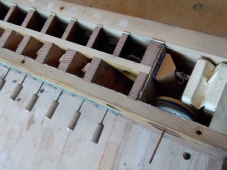
This is cambridgeorganists.org Designed and produced by Stephen Taylor for the Cambridge & District Organists’ Association

No 18: Blow me over..
To another place in the organ (Pneumatics)



The development of the organ is another example of technology influencing art (other examples include synthetic dyes and paint in tubes in the C19 heralding in the impressionosts and the Power MOSFET transistor in C20 enabling heavy metal rock music). Pneumatic technology (left, top) allowed pipes to be off chest in this simplest example. Lead tubing carries wind from the windchest to activate the small bellow (pneumatic motor) which opens the pallett to admit air to a pipe too large to fit on the windchest.
Pneumatic action developed quickly to allow building of large and powerful romantic style organs, unrestrained by conventional layout. Complex couplers and thumb piston registration became possible. Large instruments contain very long total length of lead, or more modern red plastic, compo tubing. When Manders rebuilt the organ in Eton Upper Chapel they underestimated how much they would need to finish the job. Total length over a kilometre if I remember correctly.
An ingenious example of pneumatic action appeared in The Cassons Patent organ, a 44 note compass hymn accompanying instrument, which boasted a top note solo chest (middle and bottom pictures) employing two octaves of viole from middle c. The wind passed from chamber to chamber until the highest note with the pushrod lifted was reached, sounding just this pipe.
It is theoretically possible to build a computer using late C19 pneumatic action organ components to make the binary units of computers -
With the development of electric primary action complex switching became even easier, switching logic, and nowadays computer control.
Cue another page in due course.